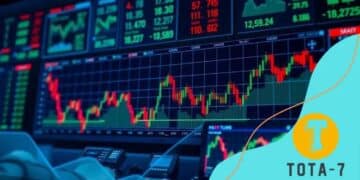Carbon offset markets investigated for greenwashing

Carbon offset markets are evolving to increase transparency and accountability, addressing greenwashing while ensuring genuine sustainability efforts are recognized and supported through stricter regulations and verification processes.
Carbon offset markets investigated for greenwashing shed light on a complex issue that affects sustainability efforts worldwide. These markets promise a way for companies to mitigate their emissions, but how effective are they really? Let’s dive into this intriguing topic.
Understanding carbon offset markets
Understanding carbon offset markets is vital as sustainability becomes more important. These markets allow companies to buy credits that represent a reduction in carbon emissions. In essence, purchasing a credit means that a company is supporting projects designed to reduce carbon footprints.
What Are Carbon Offsets?
Carbon offsets are a way to compensate for emissions produced by activities like driving or flying. When someone buys a carbon offset, they fund projects that absorb or prevent an equivalent amount of carbon dioxide from entering the atmosphere. These projects can include reforestation and renewable energy initiatives.
How Do Carbon Offset Markets Work?
Carbon offset markets operate on a simple premise: companies need to offset their carbon emissions to achieve sustainability goals. Here’s a quick overview of their functionality:
- Companies calculate their total greenhouse gas emissions.
- They purchase carbon credits that correspond to the amount they wish to offset.
- The bought credits go toward funding verified projects.
When companies engage in these markets, they participate in a larger effort to reduce global emissions. It’s essential for these markets to be transparent and accountable. However, problems can arise when companies use them without genuinely reducing their emissions.
Greenwashing occurs when businesses mislead stakeholders about their environmental practices. This can undermine the integrity of carbon offset markets. Ensuring that offset projects are legitimate is crucial for maintaining trust.
Benefits of Carbon Offset Markets
Engaging in carbon offset markets provides several benefits:
- Supports sustainable projects that contribute to ecological health.
- Encourages companies to become more socially responsible.
- Helps in achieving emissions reduction targets.
In conclusion, understanding these markets can help individuals and businesses navigate their choices within a growing field. As carbon offset markets continue to evolve, maintaining integrity is key to their future success.
The role of verification in offsets

The role of verification in offsets is crucial for ensuring that carbon offset projects deliver on their promises. Verification helps maintain trust in these markets by confirming that the emissions reductions claimed are real and quantifiable.
What is Verification?
Verification involves independent assessments of carbon offset projects. This process checks if these projects are genuinely reducing greenhouse gas emissions as claimed. It ensures projects meet specific standards and comply with regulations.
The Verification Process
The verification process can have several steps:
- Initial assessment of the project design.
- Regular monitoring of the project’s impact over time.
- Final verification to confirm total emissions reductions.
Being thorough in this process is essential. Without verification, companies might invest in projects that do not provide real environmental benefits. It is important for offset providers to demonstrate credibility through rigorous verification.
Standards and Certifications
Different organizations create standards for verifying carbon offsets. Some of the most recognized include:
- Verified Carbon Standard (VCS)
- Gold Standard
- Climate Action Reserve
These standards guide projects to ensure high-quality offsets. They also help buyers understand what they are purchasing. When companies choose verified projects, they support authenticity and transparency.
Overall, verification serves as a cornerstone of successful carbon offset markets. It builds confidence in the process and encourages responsible investment in sustainability initiatives.
Identifying signs of greenwashing
Identifying signs of greenwashing is essential for consumers and investors. It helps to separate genuine sustainability efforts from misleading claims. As companies seek to present an environmentally friendly image, recognizing the signs of greenwashing becomes crucial.
Common Signs of Greenwashing
Many companies engage in practices that may appear eco-friendly but lack substance. Here are some common indications of greenwashing:
- Vague language that lacks specifics about environmental benefits.
- Exaggerated claims that are difficult to verify.
- Products marketed as “eco-friendly” without certification.
Being aware of these signs can help consumers make informed decisions. For instance, if a company promotes a product as green without providing evidence or third-party endorsement, there may be cause for skepticism.
Checking Certifications
One effective way to identify genuine sustainability is by checking for recognized certifications. Certifications can validate claims and ensure that products meet specific standards. Reputable certifications include:
- LEED (Leadership in Energy and Environmental Design)
- Energy Star
- Fair Trade Certified
These logos can help consumers trust that a product’s environmental claims are backed by independent verification.
It’s also essential to research a company’s overall practices. A single green product does not mean a company is environmentally responsible. Look for comprehensive sustainability initiatives and practices across all operations. Understanding a company’s full environmental footprint can reveal whether they are genuinely committed to sustainability or merely engaging in greenwashing.
Consumer Awareness and Advocacy
Consumers play a vital role in combating greenwashing. By staying informed, asking questions, and demanding transparency, people can encourage companies to adopt genuine sustainability practices. Advocating for clearer regulations regarding marketing claims can also make a significant difference.
In summary, awareness of greenwashing signs helps consumers make responsible choices. By identifying misleading practices, individuals can support businesses that truly prioritize the environment.
Case studies of deceptive practices
Examining case studies of deceptive practices in carbon offset markets reveals the challenges that arise when companies misrepresent their environmental efforts. These instances not only undermine consumer trust but also hinder genuine sustainability initiatives.
Notable Examples of Greenwashing
Several high-profile companies have faced backlash for their greenwashing tactics. For instance, some brands claimed their products were made from recycled materials while only a small percentage of the product was actually recycled. This practice misleads consumers and dilutes the effort of companies genuinely committed to sustainability.
Company Profiles
Let’s take a look at a few examples:
- One fashion retailer advertised its clothing line as “eco-friendly,” neglecting to mention that production processes emitted significant greenhouse gases.
- A major beverage company promoted a small line of organic drinks while its core offerings remained heavily reliant on plastic packaging.
- A notable oil company invested in marketing renewable energy projects, but continued to expand its fossil fuel operations.
These cases illustrate the gap between marketing claims and actual practices. Companies may leverage the appeal of sustainability to boost sales without making meaningful changes.
The Impact of Deceptive Practices
The repercussions of these deceptive practices are significant. Besides eroding consumer trust, they can lead to regulatory scrutiny and legal challenges. When companies are uncovered, they often face public outcry and damage to their brand reputation. Moreover, genuine environmental initiatives suffer as consumers grow skeptical of all green claims.
This skepticism can slow the progress of actual sustainability efforts in the market, as well-meaning companies struggle to gain recognition amid the noise of misleading claims. Recognizing these case studies is essential for consumers and advocates alike, fostering a climate that demands transparency and accountability.
Future of carbon offset regulations
The future of carbon offset regulations is evolving as the demand for transparency and accountability increases. Governments and organizations worldwide are recognizing the need for clearer rules to ensure that carbon offset markets fulfill their promise.
Emerging Trends in Regulation
As sustainability becomes a priority, several trends are emerging in carbon offset regulations:
- Stricter verification processes to authenticate claims.
- Increased focus on longer-term environmental impacts.
- Global collaboration to create unified standards.
These trends indicate that regulators are becoming more proactive in addressing potential greenwashing and ensuring that carbon offset projects deliver real benefits.
Potential Challenges
Despite advancements, challenges remain. Balancing regulation and market flexibility is crucial. Over-regulating could stifle innovation and make it difficult for smaller companies to participate. It is vital to create a supportive framework that encourages genuine environmental initiatives.
Moreover, the quality of offsets varies widely. Ensuring that all projects meet high standards is essential to maintain trust in the market. Tools for assessing and comparing projects can help consumers make informed choices.
Future Prospects
Looking ahead, regulations may increasingly include guidelines on social impacts alongside environmental ones. This evolution could lead to a more comprehensive approach to sustainability, addressing issues like community welfare and equity.
Furthermore, technology will play a critical role. Innovations in blockchain and data verification could enhance traceability and transparency in the carbon offset market. Consumers and businesses will be better informed, leading to more responsible purchasing decisions.
As the regulatory landscape shifts, engagement from all stakeholders—governments, businesses, and consumers—will shape the successful future of carbon offset markets.
FAQ – Frequently Asked Questions About Carbon Offset Markets
What are carbon offsets?
Carbon offsets are reductions in greenhouse gas emissions, used to compensate for emissions produced by activities like travel or manufacturing.
How can I identify greenwashing in companies?
Look for vague claims, lack of certifications, or companies that promote one green product while their main operations remain harmful to the environment.
Why is verification important in carbon offset projects?
Verification ensures that the emissions reductions claimed by projects are real and quantifiable, helping build trust in the carbon offset market.
What role do regulations play in carbon offset markets?
Regulations help establish standards and accountability in the market, ensuring that companies provide genuine sustainability claims and reducing the risk of greenwashing.





